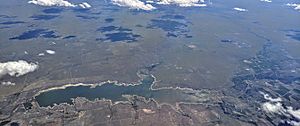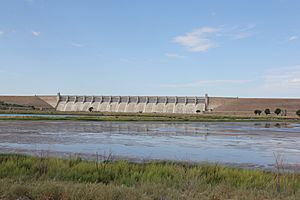John Martin Reservoir facts for kids
Quick facts for kids John Martin Reservoir |
|
|---|---|

View of the reservoir looking west from John Martin Dam (2014)
|
|
| Location | Bent County, Colorado |
| Coordinates | 38°04′23″N 103°01′41″W / 38.07306°N 103.02806°W |
| Type | Reservoir |
| Primary inflows | Arkansas River |
| Primary outflows | Arkansas River |
| Catchment area | 18,915 sq mi (48,990 km2) |
| Basin countries | United States |
| Managing agency | U.S. Army Corps of Engineers |
| Built | 1939 |
| First flooded | January 1943 |
| Surface area | 11,658 acres (47.18 km2) |
| Average depth | 5–10 ft (1.5–3.0 m) |
| Max. depth | 60 ft (18 m) |
| Water volume | Full: 340,771 acre⋅ft (420,335,000 m3) Current (Dec. 2015): 224,000 acre⋅ft (276,000,000 m3) |
| Shore length1 | 22 mi (35 km) |
| Surface elevation | Full: 3,852 ft (1,174 m) Current (Dec. 2015): 3,840 ft (1,170 m) |
| Settlements | Caddoa, Hasty, Las Animas |
| 1 Shore length is not a well-defined measure. | |
John Martin Reservoir is a large reservoir (an artificial lake) located in southeastern Colorado. It was built on the Arkansas River by the U.S. Army Corps of Engineers. This important reservoir helps control floods, provides water for farms, and offers many fun activities like boating and fishing. The beautiful John Martin Reservoir State Park is also found along its shores.
Contents
Why Was John Martin Reservoir Built?
In the 1930s, there were often big floods along the Arkansas River. A politician from Colorado named John Andrew Martin worked hard to get a law passed in the U.S. Congress. This law allowed a reservoir to be built to stop these floods.
Building the Dam and Reservoir
In 1939, President Roosevelt signed the law, and the U.S. Army Corps of Engineers started building the dam. This was a huge project! The government had to buy over 20,000 acres (81 km2) of land. They even had to move about 21 miles (34 km) of Santa Fe Railway tracks.
Construction of the dam and reservoir began in the fall of 1939. Sadly, John Martin passed away that same year. In his honor, the dam and reservoir were renamed after him in June 1940. Water began to fill the reservoir in January 1943. The project faced some delays because of World War II, but the dam was finally finished in October 1948.
Sharing Water: The Arkansas River Compact
In December 1948, the states of Colorado and Kansas signed an agreement called the Arkansas River Compact. This agreement decided how both states would share the water from the Arkansas River, including the water in John Martin Reservoir. Later, in 1980, they agreed that Colorado would get 60% of the reservoir's water and Kansas would get 40%.
Sometimes, there have been disagreements between the two states about this water sharing. This led to a long legal case called Kansas v. Colorado.
Where is John Martin Reservoir Located?

John Martin Reservoir is in southeastern Colorado. It sits in a flat area called the Colorado Piedmont, which is part of the larger Great Plains. The entire reservoir is located within Bent County.
The Dam and River Flow
The reservoir is held back by the John Martin Dam on its eastern side. The Arkansas River flows into the reservoir from the west and then flows out of it to the east. Smaller streams like Rule Creek (from the south) and Gageby Creek (from the north) also flow into the reservoir.
Nearby Towns and Roads
U.S. Route 50 runs north of the reservoir, going from east to west. Colorado State Highway 183 goes north and south near Fort Lyon, which is northwest of the reservoir. A BNSF Railway train line runs along the southern edge of the reservoir.
The city of Las Animas is about 4 miles (6.4 km) west of the reservoir. The small community of Hasty is about 2 miles (3.2 km) north of the reservoir's eastern end. Another small community called Caddoa is right next to the dam on the east side.
How Big is the Reservoir?
The size of John Martin Reservoir changes depending on how much water flows in and what the weather is like. The U.S. Army Corps of Engineers divides the reservoir into different sections based on how much water they hold.
When the reservoir is full for recreation and conservation, it covers about 11,658 acres (47.18 km2) of land. At this level, the water is about 3,852 feet (1,174 m) high. The deepest part of the reservoir can be up to 60 feet (18 m) deep.
What is the Dam Like?
John Martin Dam is an earth-fill embankment dam. This means it's a large wall made mostly of earth and rock. It stands 118 feet (36 m) tall and stretches for about 2.6 miles (4.2 km) (that's over 4 kilometers!) across the land.
Part of the dam is a concrete spillway with 16 gates. These gates can be opened to let water out into the Arkansas River, especially during floods.
Who Manages the Reservoir?
The U.S. Army Corps of Engineers manages the dam and reservoir. Their main jobs are to control floods and make sure there's enough water for irrigation (watering crops).
Colorado Parks and Wildlife is in charge of the reservoir's surface and all the fun things people do there. This includes managing John Martin Reservoir State Park. They also look after a large area of 19,471 acres (78.80 km2) next to the park, which is called the John Martin Reservoir State Wildlife Area.
Fun Things to Do at John Martin Reservoir
John Martin Reservoir State Park is a great place for outdoor activities. It's located on the north side of the reservoir's eastern end.
- Boating and Camping: The park has places to launch boats and areas for camping.
- Hiking: There's a hiking trail for exploring the area.
- Swimming: Below the dam, there's a smaller lake called Lake Hasty with a swimming beach.
- Fishing: John Martin Reservoir is a popular spot for fishing. You can catch fish like saugeye, wiper, white bass, crappie, and catfish. These fish are added to the reservoir when needed.
- Hunting: Hunting is not allowed in the state park, but it is permitted in the nearby wildlife area.
Interesting Places to Visit Nearby
- Santa Fe Trail: A preserved section of the historic Santa Fe Trail is located north of the reservoir. A special marker tells its story.
- Fort Lyon National Cemetery: This cemetery is just west of the reservoir.
Wildlife at John Martin Reservoir
John Martin Reservoir is a fantastic place for wildlife, especially birds!
Birds
With 373 different kinds of birds seen in Bent County, the reservoir is a top spot for birdwatching. In the winter, you can often see many bald eagles in the area. During one winter (2001-2002), 126 eagles were counted!
Other Animals
Besides birds, you might also spot other animals like deer, prairie dogs, rabbits, raccoons, and squirrels living around the reservoir.




